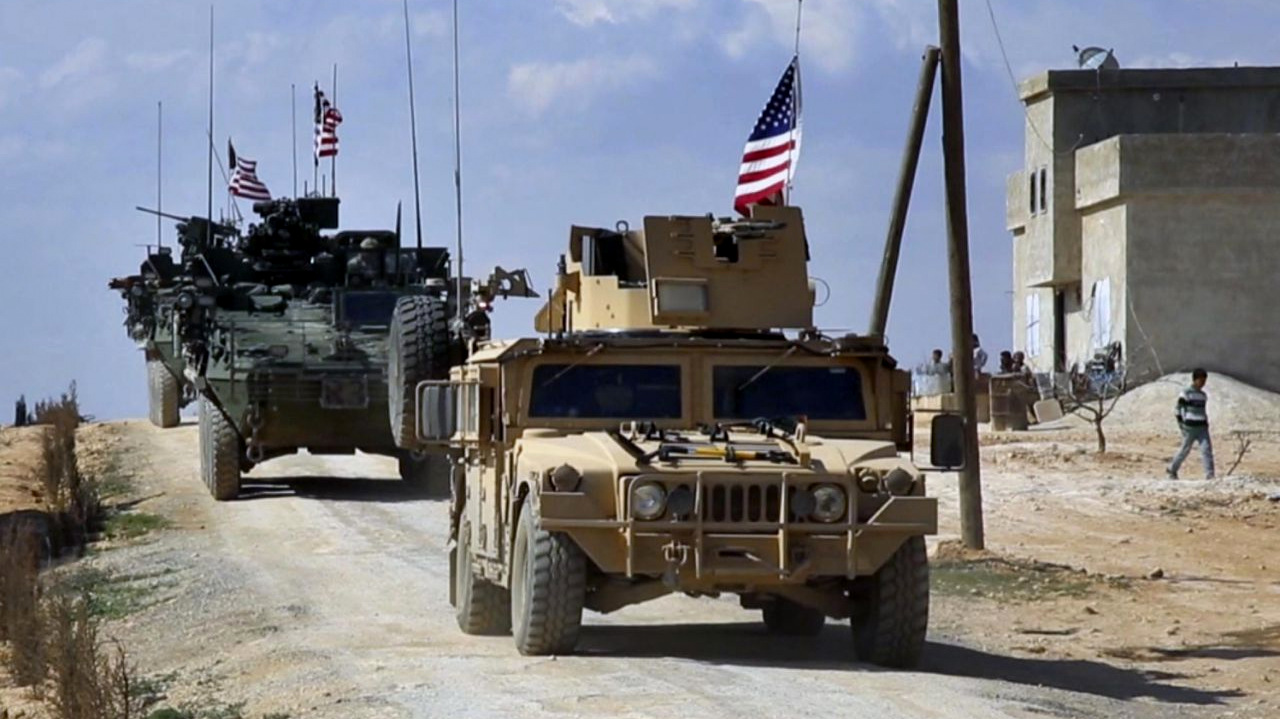
U.S. forces patrol on the outskirts of
the Syrian town, Manbij, a flashpoint
between Turkish troops and allied Syrian
fighters and U.S.-backed Kurdish
fighters, in al-Asaliyah village, Aleppo
province, Syria, March 7, 2017. (Arab 24
via AP)
April 05, 2017 "Information
Clearing House"
- "MPN"
-
MINNEAPOLIS–
Soon after his
inauguration, President Trump stoked
concerns regarding of U.S. intervention in
Syria after
announcing his plan to create so-called
“safe zones” within Syria. At the time,
Trump had ordered Secretary of State Rex
Tillerson, along with Secretary of Defense
James Mattis, to create a plan within 90
days to create such “zones” within Syria in
order to allow refugees in the war-torn
nation to “await firm settlement, such as
repatriation or potential third-country
resettlement.”
Trump stated that this approach was
preferable to the strategy adopted by
European Union nations that resulted in the
controversial influx of millions of refugees
from Syria and other countries. As analysts
noted at the time, the move, despite its
allegedly humanitarian motivations, risked
sparking something much more grave: the
escalation of U.S. military involvement in
Syria, which would greatly heighten the risk
of conflict between the US. and the Syrian
government, along with its Russian allies.
Now, it appears that Tillerson and Mattis
are quickly approaching the completion of
their strategy for the establishment of
Syrian “safe zones”
after Tillerson recently confirmed the
administration’s commitment to the measure
in both Syria and Iraq at a summit held for
a 68-member U.S.-led coalition that is
targeting Daesh.
Though the details of the plan have yet
to be released, many members of the
coalition and members of previous U.S.
presidential administrations have voiced
their concerns that “safe zones” would be
ineffective, concerns that
Trump himself once echoed in criticizing
Hillary Clinton’s advocacy for such zones in
the 2016 election. For example,
Portuguese Foreign Minister Augusto Santos
Silva stated that his government was
“never close to favoring this solution,”
arguing that forcing refugees “to stay in
their country when you cannot ensure that
they won’t be attacked by some of the
warring factions” fails to comply with
international law.
Indeed, the U.S.-led coalition seems
quite unqualified to oversee civilian
safety, as bombing campaigns in recent
months have claimed
more innocent Syrian and
Iraqi lives than military actions taken
by Daesh
or any other faction currently active in
those countries.
In addition, tensions between coalition
members and some U.S. allies in the region
threaten even the feasibility of
establishing the zones in the first place.
Any plan to establish the zones would
require cooperation with Russia and Syria,
who are likely to oppose any such measure,
as the zones would
necessitate a massive increase in the
U.S. military presence in Syria.
Furthermore, the zones are set to be held by
a still undetermined mix of Turkish, Kurdish
and Western forces – an unlikely combination
due to
the often explosive antagonism between
the Turks and the Kurds.
Brian McKeon, former undersecretary of
defense for policy in the Obama-era
Pentagon, echoed such concerns, stating that
safe zones would be counter-productive in
the fight against Daesh in
an interview with Foreign Policy:
“A safe zone in theory assumes some
agreement on the part of the Russians, Turks
and possibly Syrians to yield sovereignty,
or you don’t have agreement. The number of
assets it would take to defend against
potential attacks would likely be to the
detriment of the counter-ISIL campaign.”

A U.S soldier kicks a gate during a
mission in Baquba, in Diyala province,
some 65 km (40 miles) northeast of
Baghdad, November 4, 2008. (Photo: Goran
Tomasevic/Reuters)
Considering that such “safe zones” will
in no way guarantee safety of any kind and
may be entirely impossible to implement due
to Turkish-Kurdish tensions, the Trump
administration’s commitment to such measures
– along with other actions they have
recently taken in the region – suggest that
their real motivation is something else
entirely.
Most telling of all is the fact that the
debate over safe zones has coincided with
the increased movement of U.S. troops and
military assets into Syria and Iraq, such as
the U.S.’
recent deployment of 2,500 soldiers to
both Iraq and Syria. In addition, the U.S.
government has signaled that these troops
will remain in those nations long after
Daesh is no longer deemed a threat.
For instance, hidden within the
announcement of U.S. troop deployment in the
Syrian city of Raqqa was the admission that
the troops
will be “required” to stabilize the
region after Daesh’s defeat, as U.S.
officials anticipate that “America’s allies”
will need assistance in establishing
“Syrian-led peacekeeping efforts” in the
region for the foreseeable future. As for
the forces to be deployed to Iraq, Tillerson
confirmed that they
would remain in Iraq after the defeat of
Daesh in Mosul, despite his promise that no
“nation-building” would take place
afterwards.
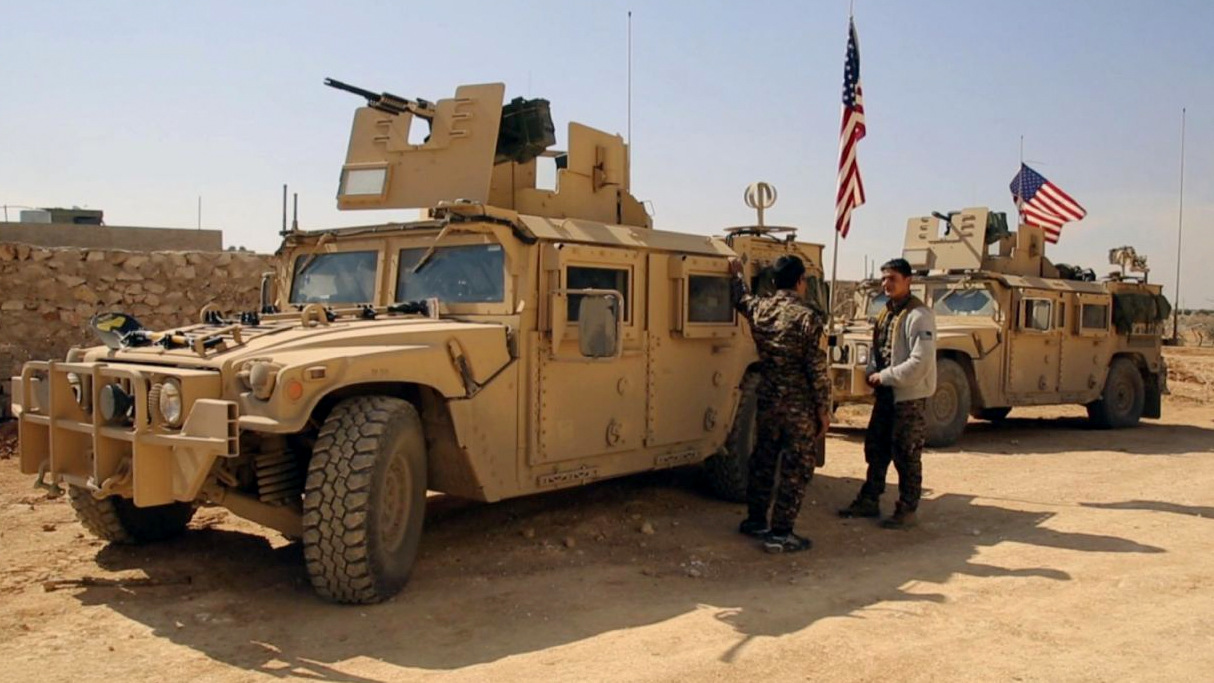
Syrian rebel fighters stand near U.S
military vehicles on the outskirts of
the Syrian town, Manbij, Syria, March 7,
2017. (Arab 24 via AP)
Any additional forces deployed in Syria
and Iraq for the establishment of “safe
zones” would also ostensibly form part of an
indefinite military presence within nations
that
have not authorized their operations
within their borders – making these troop
movements tantamount to an invasion.
Moreover, the recent announcement from the
Pentagon that they
would no longer be publicly announcing
subsequent troop deployments suggests that
the U.S. government is seeking to obfuscate
what is set to be a drastic increase in U.S.
military presence in both Syria and Iraq –
an increase set to spark geopolitical
tensions in the region and beyond.
Ultimately, these safe zones – despite
their humanitarian function – seem to be
nothing more than an excuse to justify an
increased U.S. military presence within
Syrian and Iraqi borders – forces which, by
the military’s own admission, have no
intention of leaving anytime soon.
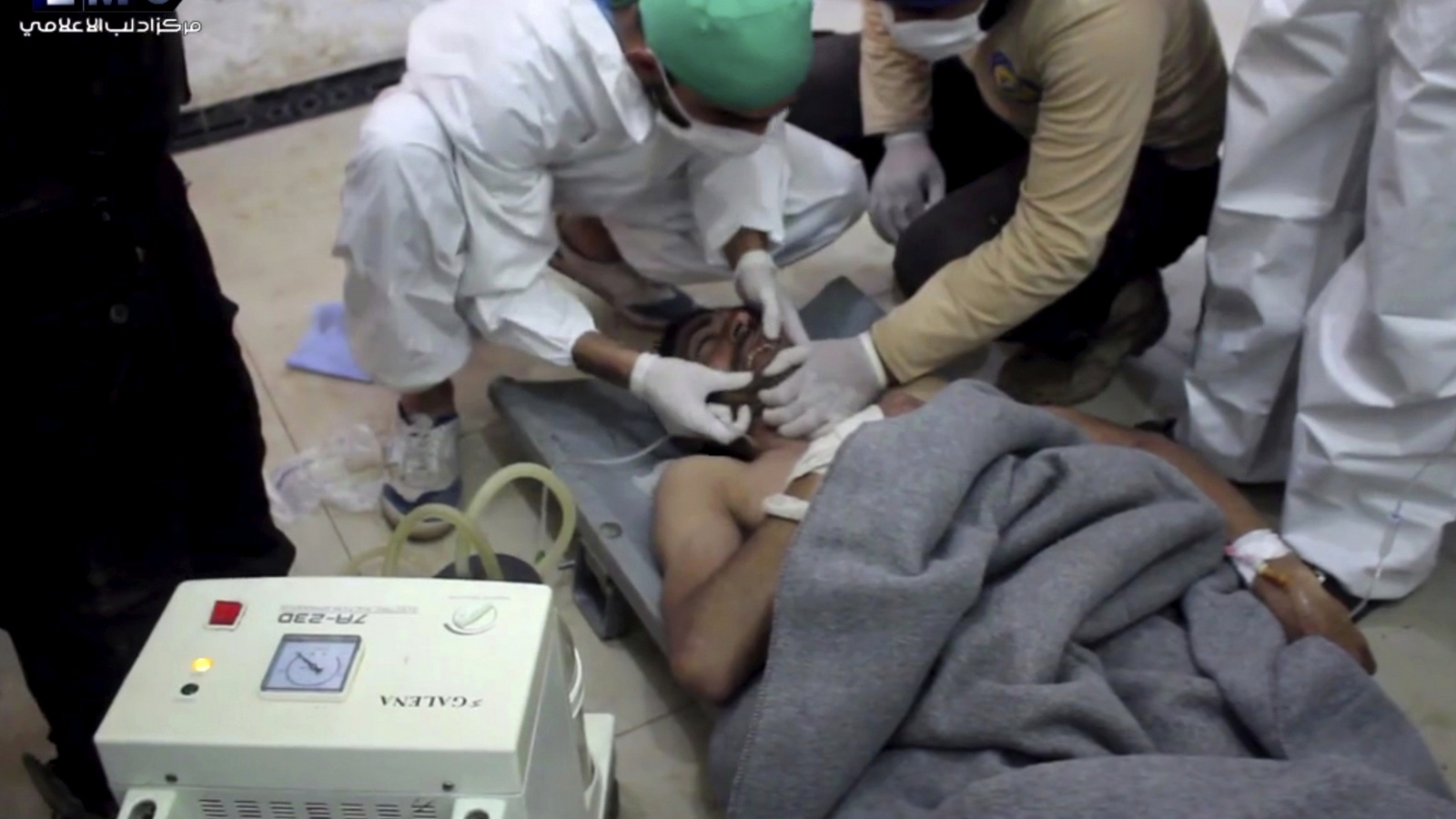
This frame grab from video provided on
Tuesday April 4, 2017, by the Syrian
anti-government group, the Edlib Media
Center, shows an alleged victim of a
suspected chemical attack as he receives
treatment at a makeshift hospital, in
the town of Khan Sheikhoun, northern
Idlib province, Syria. (Edlib Media
Center, via AP)
MINNEAPOLIS
— After an unsuccessful attempt to blame the
Syrian government for a
2013 gas attack in Ghouta
that was most
likely carried out by al-Qaeda’s Al-Nusra
Front, the U.S.-led coalition’s pretext for
a military intervention in Syria to oust
President Bashar al-Assad has largely
crumbled as Russian diplomats
were able to negotiate a deal
with the United Nations on behalf of their
Syrian allies.
Nearly four years later, history seems to be
repeating itself, with Syria’s government
being accused, once again by NATO allies, of
carrying out yet another chemical weapons
attack in al-Qaeda-held Idlib Province. The
attack has left at least 58 dead.
|
No
Advertising - No Government Grants - This Is Independent Media
|
But this time
the stakes are higher, as the U.S.-led
coalition has recently deployed
thousands of troops
in Syria that are set to remain long after
Daesh and other terrorist groups are
eradicated. To make matters worse, Vitaly
Churkin, the Russian UN envoy
who helped negotiate
the 2013 agreement and prevent U.S.-led
military intervention, lies dead
under still -undisclosed circumstances.
With coalition members already accusing the
Syrian government of violating the 2013
agreement, it appears that the specter of
foreign military intervention in the
embattled nation may again be on the table,
threatening the peace conference regarding
Syria
set to begin today
in Brussels.
For the U.S.
and its allies, the timing couldn’t be
better to finalize their regime change
operation in Syria – an operation that
has been documented for over 25 years.
A
familiar pattern
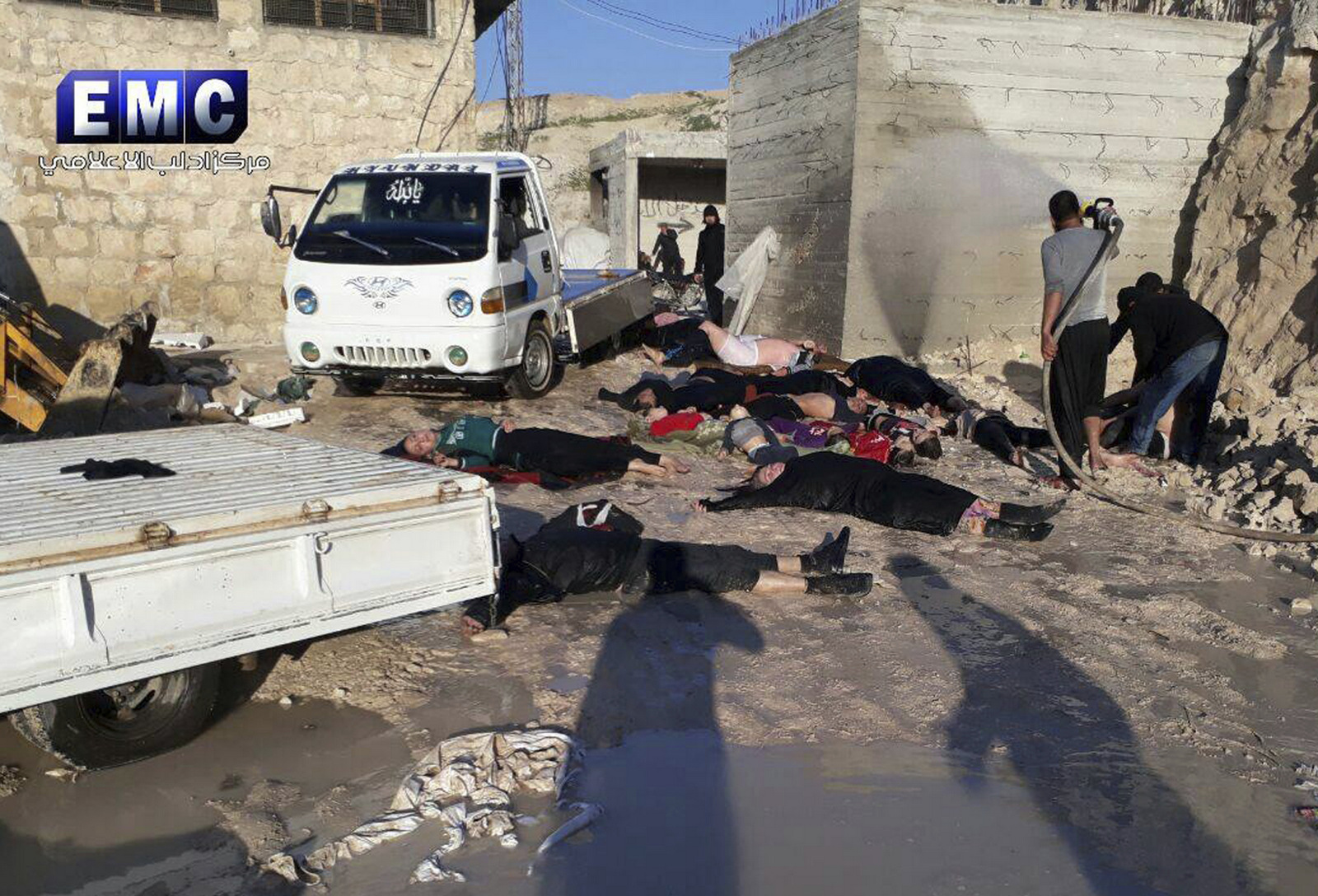
This frame grab from video provided on
Tuesday April 4, 2017, by the Syrian
anti-government group, the Edlib Media
Center, shows victims of a suspected
chemical attack, in the town of Khan
Sheikhoun, northern Idlib province,
Syria. (Edlib Media Center, via AP)
News broke early Tuesday morning of yet
another tragedy in the nearly six-year-long
“civil war” in Syria, this time in the
northwestern province of Idlib, where a
chemical gas attack is estimated to have
killed 58 people, including 11 children,
according to multiple media reports. Two
groups – the White Helmets and the Syrian
Observatory for Human Rights – have blamed
the Syrian government for the attack.
The Syrian Army
has flatly denied the charges,
stating that the army
“has not and does not use [chemical
weapons], not in the past and not in the
future, because it does not have them in the
first place” – a reference to the 2013
agreement whereby the Syrian government
dismantled its chemical weapon stores as
part of the accord that avoided U.S.-led
military intervention.
However,
mainstream media reports
along with
Western nations
are already adopting the accusations against
the Syrian government as fact. In a
near-repeat of 2013, these nations seem
unwilling to confirm such grave accusations
before taking action, seemingly content to
take the words of these two groups as sound
despite significant evidence pointing to
their disrepute.
Both of the groups who have blamed Assad’s
forces for the attack have come under fire
repeatedly for their ties to
pro-intervention institutions, NATO-allied
governments and even al-Qaeda – all of whom
who have a stake in regime change.
The White
Helmets, for instance,
were founded by
a former British army officer turned
mercenary and frequently
worked with Purpose, Inc.
– a George Soros-funded PR firm that has
been pushing for Western intervention in
Syria for years. They also receive millions
in funding from Western governments,
including 23 million dollars from the U.S.,
and operate almost exclusively in areas held
by al-Nusra Front, a Syrian al-Qaeda
affiliate, with whom they
have collaborated with
on a regular basis. They have been caught on
camera
facilitating public executions
of civilians in Aleppo and elsewhere.
The Syrian
Observatory for Human Rights (SOHR) is
equally dubious, but for different reasons.
Unlike the White Helmets, the Syrian
Observatory for Human Rights
consists of just one man,
an anti-Assad Syrian national by the name of
Rami Abdul-Rahman who lives in the United
Kingdom. Abdul-Rahman’s “sources” in Syria,
from which he receives his information
regarding the war, are anonymous and never
recorded – thus making them completely
unverifiable.
It
was these same two groups who provided much
of the “intelligence” that was used to blame
the Syrian government for the 2013 attack in
Ghouta. But once the media frenzy and
manufactured outrage in the West had died
down, it emerged that the Syrian army was
not the likely culprit behind the attack and
that it had instead been carried out by
al-Qaeda-linked rebels in the area.
A year later in
2014, former UN weapons inspector Richard
Lloyd and Professor Theodore Postol of MIT
published a report
that found that the intelligence used to
blame Assad’s forces for the attack was
grossly inaccurate. A few months later,
Pulitzer Prize award-winning journalist
Seymour Hersch confirmed that
the al-Nusra rebels in Ghouta had the means,
motive and opportunity to carry out the
attack themselves. On separate occasions,
al-Nusra was confirmed to have used chemical
weapons against civilians.
Just like
Ghouta, Idlib is dominated by al-Nusra.
Earlier this year,
even the Washington Post admitted
that Idlib’s “moderate” rebels had all but
been replaced by al-Nusra and other
terrorist factions in Syria. Aron Lund of
the Century Foundation
told the Post
that “Idlib is now basically being abandoned
to the jihadis. This might be the end of the
opposition as understood by the opposition’s
backers abroad. They won’t have any reason
to support it.”
If
Western governments and media outlets repeat
the mistakes of 2013 by not verifying the
claims made by the White Helmets or the
one-man show at SOHR, they may very well end
up offering these extremist groups support
if they prematurely choose to retaliate
against Assad before the dust can settle.
Will
intervention be on the table?
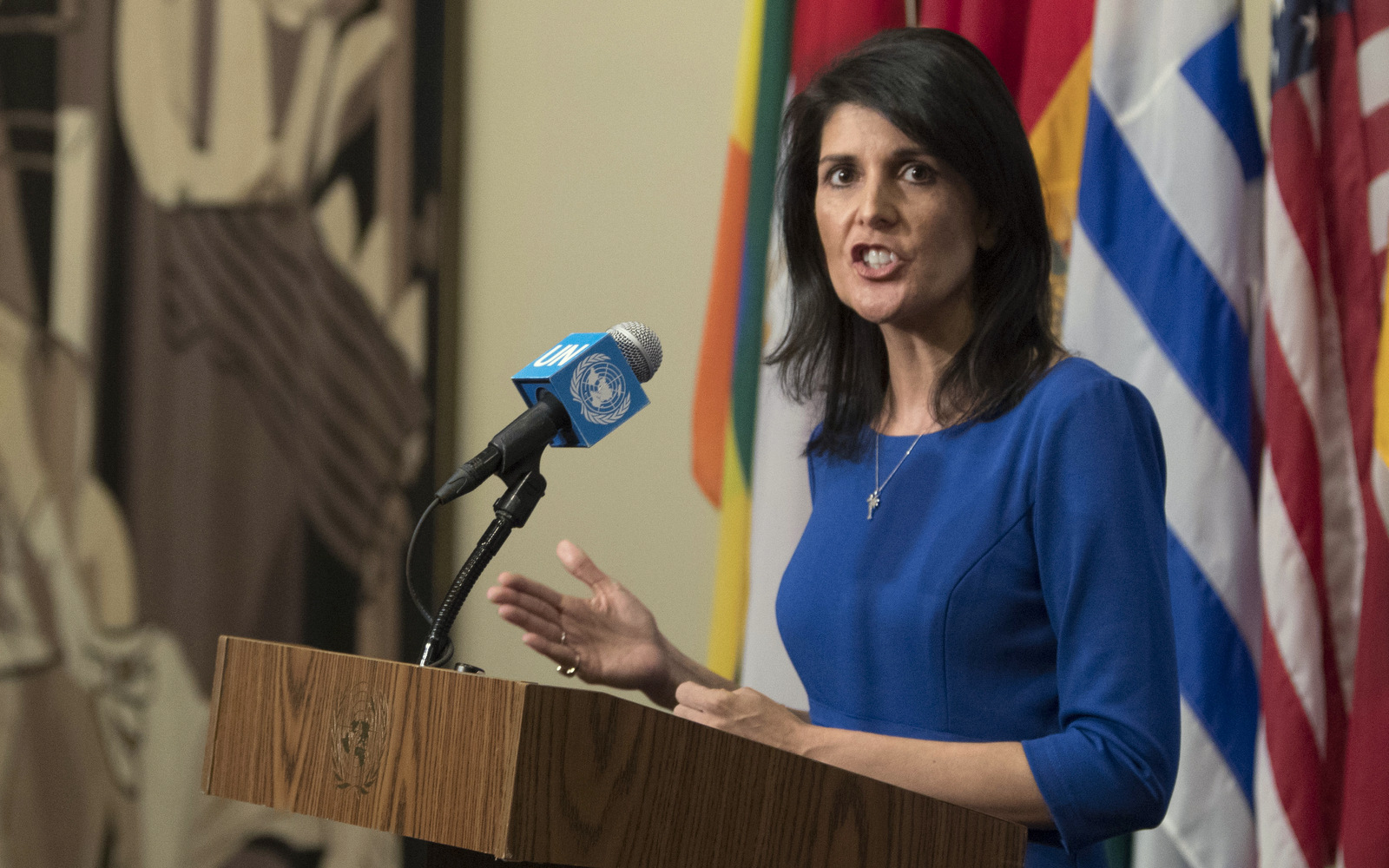
United States Ambassador to the United
Nations Nikki Haley speaks to reporters
after a Security Council meeting on the
situation in the Middle East, Thursday,
Feb. 16, 2017 at U.N. headquarters.
(AP/Mary Altaffer)
However, the
U.S.-led coalition and NATO nations seem
less interested in the veracity of the
information than in the opportunity these
accusations – however baseless and dubious
they may be – offer for their long-standing
goals of regime change in Syria. Immediately
after news of the attack broke, with only
the White Helmets and SOHR testimony as
sources, France – a U.S. coalition member –
called for an emergency meeting
of the UN Security Council to discuss how to
respond to the “disgusting” attack, a
meeting now set to take place Wednesday
morning. Hours later, EU diplomatic chief
Federica Mogherini
said that Assad bears “primary
responsibility”
for the attack. If more countries choose to
lay the blame on Assad for the attack, the
2013 agreement could easily crumble – making
Syria once again vulnerable to foreign
military intervention.
The Associated
Press reported that the U.S. envoy to the UN
Nikki Haley condemned the attack as
“terrible” but stopped short of blaming
Assad directly. However, Haley
said just yesterday
that the Syrian people no longer wanted
Assad as leader after telling ABC News on
Sunday that “Assad is always a priority” and
that the U.S. planned to bring him to
justice. These comments stray far from the
rhetoric recently used by U.S. Secretary of
State Rex Tillerson, who
said last Thursday
that the long-term status of “President
Assad will be decided by the Syrian people.”
Haley’s recent
statements suggest that the Trump
administration’s approach is quickly
shifting and will likely shift even more due
to these latest accusations targeting the
Syrian government. While some in the Trump
administration, such as Tillerson, have
publicly called for a non-interventionist
approach in Syria – something which Trump
himself has long promised –
recent U.S. military actions in Syria
suggest
that the real strategy is something else
entirely.
As
MintPress previously reported,
Trump’s
recent deployment of 2,500 troops
to the Middle East – which are to be divided
between Syria and Iraq – suggests that the
U.S. is preparing for more than just a
“final assault” against Daesh, especially
considering that the Army even admitted that
troops would stay in Syria long after
Daesh’s defeat to “stabilize” the region for
its “allies.”
In addition,
recent moves by the administration
to create “safe zones”
in Syria would also require the U.S. to
significantly increase its troop deployments
in Syria – troops that would remain in the
country indefinitely. Indeed, the Pentagon
has suggested that future troop deployments
in Syria will be significant, as it is
no longer publicly announcing
future deployments or troop movements. All
of this despite the fact that Assad has
stated that U.S. forces were not invited
into the country and that they
are essentially “invaders.”
Given that this latest gas attack is already
being used politically in a similar fashion
to the Ghouta attack of 2013, it seems
likely that Assad will once again become a
target of this quickly-growing standing army
of foreign soldiers within its borders – one
that has amassed under the cover of offering
humanitarian assistance and “fighting
terrorism.”